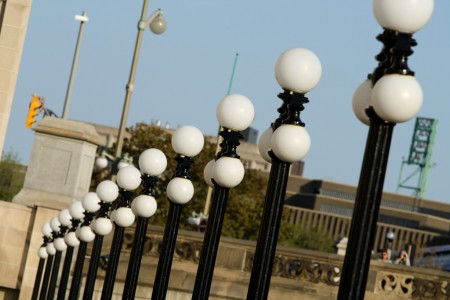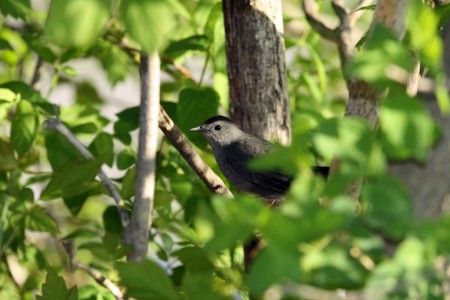Amusing. Subtleties definitely get lost along the way, and people often use whatever results they see to bolster their pre-existing convictions.
Month: May 2009
Climate sensitivity roulette
As discussed several times previously, two of the key uncertainties relating to climate change is (a) how much temperature would increase in response to any particular change in the atmospheric concentration of greenhouse gasses and (b) what humanity will actually emit between now and the achievement of global carbon neutrality. One way to express those uncertainties colourfully is with the Roulette wheels the MIT Joint Program on the Science and Policy of Global Change has created.
The wheels are based on results from the MIT Integrated Global Systems Model and have shaded areas proportional in size to different possible levels of temperature increase. The projections were recently updated, and the new ones contain significantly higher estimates of the risks of high levels of warming:
The new projections, published this month in the American Meteorological Society’s Journal of Climate, indicate a median probability of surface warming of 5.2 degrees Celsius by 2100, with a 90% probability range of 3.5 to 7.4 degrees. This can be compared to a median projected increase in the 2003 study of just 2.4 degrees. The difference is caused by several factors rather than any single big change. Among these are improved economic modeling and newer economic data showing less chance of low emissions than had been projected in the earlier scenarios. Other changes include accounting for the past masking of underlying warming by the cooling induced by 20th century volcanoes, and for emissions of soot, which can add to the warming effect. In addition, measurements of deep ocean temperature rises, which enable estimates of how fast heat and carbon dioxide are removed from the atmosphere and transferred to the ocean depths, imply lower transfer rates than previously estimated.
The ‘policy’ wheel assumes aggressive mitigation action, while the ‘no policy’ wheel assumes a business-as-usual course. It is notable that the chances of keeping warming below 2°C are infinitesimal, on that wheel. Even with aggressive action, our changes of keeping below 2°C of increase are looking increasingly distant, with effects that may be severe for both human and natural systems.
In addition to being a good visual image, I like the conceptual linkage between climate change and gambling. We are certainly taking a chance, whatever we do, but science can help us to assess the odds we face and make choices that reduce the risks of unacceptable outcomes.
Using the degree symbol
While this probably won’t be useful to most readers, I thought I would share how to produce the degree symbol (°) using only your keyboard, on both a PC and a Mac.
On a PC: Hold the Alt key, then type 0176 on the numeric keypad, and release the Alt key.
On a Mac: Hold the Option key, type k, release the Option key.
In Mac software, the symbol for the Option key looks like a two-pronged fork. The confusing key names and symbols are one of the things I like least about Macs. They really put me off using hotkey combinations, even though I have been using Macs daily for about four years now.
Anyhow, you can now use the appropriate symbol when writing phrases like: “avoiding a mean temperature increase of more than 2°C above pre-industrial levels.”
Coal cancellations in the US
The Economist has been bold enough to suggest that ‘the writing is on the wall’ for coal-fired power plants in the United States, unless they can be converted to run on biomass or incorporated into other ‘green’ compromises. While there have apparently been 97 coal plants cancelled since 2001 (and nine so far this year), those that are operating now are long lived; their contribution to US emissions will barely fall between now and 2030. Unusually, the article makes no mention of carbon capture and storage (CCS) technology, which many supporters of fossil-fuel based power hope will soon emerge as a cheap, safe, and effective mechanism for preventing greenhouse gas emissions. The omission is actually a welcome one, given how tempted industry groups, governments, and commenters in general have been to see CCS as a simple silver-bullet mechanism for maintaining the status quo.
Worldwide, there must be an ever-increasing determination to prevent the construction of new coal capacity, except where it incorporates safe and effective CCS technology (if that proves possible). Meeting climate change mitigation targets (including avoiding a temperature increase of more than 2°C above pre-industrial levels) probably also means a fair bit of existing coal capacity will need to be converted to biomass or brought offline before the end of its economical lifetime. That will provoke the fierce opposition of those who have invested in such projects, though that may be a necessary signal to the market at large that coal-fired power is no longer acceptable – the carbon in the world’s coal beds needs to remain there, rather than being added to an atmospheric stock that is already dangerously high.
States like Canada and the US should be working to rebuild the basis of their energy system on the basis of non-emitting and renewable options. In so doing, they will establish the prerequisites for their own prosperity in the future, as well as help develop the technologies and approaches that will make the same transition possible in rapidly growing developing states.
Photographing birds in Ontario and Quebec
I enjoy photographing birds, and been having increasing luck doing so with my new 70-200mm lens. I think it might be a good project to collect images of birds that congregate around Ottawa, Toronto, and Montreal, use them as photos of the day, and identify their species.
It can be a project a bit like collecting the Oxford colleges, though it is obviously much more open-ended.
A few I have shot with the new lens:
- Species unknown – near the Rideau Canal locks
- Rock Pigeons (Columba livia) – on Somerset
- Species unknown – Kensington Market area, Toronto
- Species unknown, possibly a House Sparrow (Passer domesticus) – Victoria University, Toronto
Can anyone put a name to the unknowns above? I will try to come up with some new bird photos during the next week or so.
P.S. Has anyone tried the Canon 1.4X or 2.0X teleconverters? Does either work with the f/4 70-200mm zoom (I remember the box saying the lens is compatible with them). Do the focusing and metering systems still work properly, despite the lost 1-2 f-stops?
Cloud cover and climate change
According to research published back in April, the biggest climate changes in the 21st century may occur more due to changes in high altitude cloud cover, in response to increased temperatures from rising greenhouse gas concentrations, rather than due to the initial temperature increases themselves: Global warming due to increasing absorbed solar radiation, published in Geophysical Research Letters.
Reduced cloud cover would reduce the amount of sunlight that gets reflected back into space, rather than striking the surface of the Earth. As such, it would produce further warming. Based on evaluation of simulations used in preparing the Fourth Assessment Report of the IPCC, this effect may be of greater magnitude than the initial warming due to increased absorption of outgoing long-wave radiation by greenhouse gasses.
While the result certainly cannot be considered definitive now, it underscores the importance of improving climate models and incorporating the key feedback effects into them. Only when that has been done can more precise estimates of the climatic sensitivity of the planet be produced, as well as more accurate regional projections.
Avian puffballs
Ottawans should consider going for a stroll or bike ride along the southern side of the Ottawa River in the next few days. It is populated with large numbers of adorable, fuzzy, yellow goslings.
I saw them in four or five clusters, between LeBreton Flats and Andrew Haydon Park. I will need to go back with a better camera.
Playing with Wolfram Alpha
Wolfram Alpha is based on a rather neat idea: making a website that can actually deal with information in an intelligent way, rather than simply search for words of things in existing pages. Put in ‘1 kg gold‘ and it will tell you that it would form a sphere 2.313cm in diameter, a cube 3.73cm to a side, and cost US$32,520. Put in ‘running 10 km/h 60 minutes 6’0″ 185lbs age 25 male‘ and it will estimate the number of calories expended. It doesn’t know about cycling yet, unfortunately. It doesn’t seem to be able to do calculations on greenhouse gas emissions yet, either, though it will tell you that mixtures of air and methane in which the methane is between 5% and 15% of the total will explode if exposed to a temperature of 595˚C. It also knows that Apple has 35,100 employees and a current P/E ratio of 23.1. It can search for base pair sequences within the human genome.
The biggest limitation of the site is phrasing things in a way it interprets properly. Indeed, most of the searches I try produce only the message: “Wolfram|Alpha isn’t sure what to do with your input.” For the time being, Wolfram Alpha is less of an open-ended vehicle for computations and data access, and more a set of discretely made tools for existing tasks. If you know which tools exist and how to format input for them, it works well. If you are trying to get it to do something its designers didn’t anticipate, it probably won’t work.
In short, Wolfram Alpha is a fun thing for statistics nerds to play around with, and could be genuinely useful for research. The best way to appreciate its current capabilities is to watch this introductory screencast.
The AECL and new nuclear plants in Ontario
It seems that the province of Ontario is leaning towards having Atomic Energy of Canada Limited (AECL) build their new nuclear reactors, provided the federal government provides some additional support. The recent history of the company isn’t very impressive, given their failure to get two comparatively simple isotope reactors to work, and giving the contract to a Canadian company makes it even more likely that Canadian taxpayers and ratepayers will end up subsidizing them.
Perhaps it would be wiser to give the contract to a French, American, or Japanese firm, and let their citizens help pay for our gigawatts. It seems plausible that using a design that is being implemented elsewhere will have price benefits: both in terms of economies of scale and in terms of learning from the experience of those who began building them earlier. AECL’s Advanced CANDU reactor has not yet been fully designed, and probably never will be unless it wins the competition in Ontario, besting France’s AREVA and Westinghouse, from the US.
New research on the meridional overturning circulation
Recent research undertaken by the Woods Hole Oceanographic Institution and Duke University suggests that ocean currents work differently from how they were previously considered to, with implications for climate change. Using a combination of two years worth of observations from underwater sensors and computer models, they determined that “much of the southward flow of cold water from the Labrador Sea moves not along the deep western boundary current, but along a previously unknown path in the interior of the North Atlantic.” If the results of this study are accurate, it could mean that previous attempts to model the climate system incorporated inappropriate behaviour for this current. As a result, they could have generated less accurate projections of how warming due to greenhouse gas concentrations will affect different parts of the climate system.
More information about the study is available in Nature: Interior pathways of the North Atlantic meridional overturning circulation. For those lacking time or access to Nature, here is the abstract:
To understand how our global climate will change in response to natural and anthropogenic forcing, it is essential to determine how quickly and by what pathways climate change signals are transported throughout the global ocean, a vast reservoir for heat and carbon dioxide. Labrador Sea Water (LSW), formed by open ocean convection in the subpolar North Atlantic, is a particularly sensitive indicator of climate change on interannual to decadal timescales. Hydrographic observations made anywhere along the western boundary of the North Atlantic reveal a core of LSW at intermediate depths advected southward within the Deep Western Boundary Current (DWBC). These observations have led to the widely held view that the DWBC is the dominant pathway for the export of LSW from its formation site in the northern North Atlantic towards the Equator. Here we show that most of the recently ventilated LSW entering the subtropics follows interior, not DWBC, pathways. The interior pathways are revealed by trajectories of subsurface RAFOS floats released during the period 2003–2005 that recorded once-daily temperature, pressure and acoustically determined position for two years, and by model-simulated ‘e-floats’ released in the subpolar DWBC. The evidence points to a few specific locations around the Grand Banks where LSW is most often injected into the interior. These results have implications for deep ocean ventilation and suggest that the interior subtropical gyre should not be ignored when considering the Atlantic meridional overturning circulation.
Improving our understanding of ocean currents should help to improve the accuracy of predictions from general circulation climate change models, and may be helpful in producing regionally specific projections of climate change impacts.





